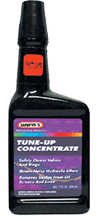PRODUCT IDENTIFICATION
| Product Name | Wynn's Tune Up Concentrated |
| Other Names | 63614A |
| Recommended Use | Lubricating oil for engines |
| Supplier Name | Wynn's Australia Pty Ltd
An (ITW), Illinois Tool Works Company
ABN 73 000 370 150 |
| Address | 100 Hassall Street, Wetherill Park N.S.W. 2164
Private Bag 35, Wetherill Park DC N.S.W. 2164 |
| Telephone Number | (02) 9828 0900
Email : wynnsaus@wynns.net
Website : www.wynns.net |
| Emergency Phone Number | (02) 9828 0900 Monday-Friday 8.00am – 5.00pm
13 11 26 (24 hours Australia) Poisons Information Centre (PIC)
0800 764 766 (New Zealand) Poisons Information Centre (PIC) |
HAZARDS IDENTIFICATION
| Hazard Classification |
HAZARDOUS SUBSTANCE. NON-DANGEROUS GOODS.
Classified as hazardous according to the criteria of NOHSC.
Not classified as a Dangerous Good according to the criteria of the
ADG Code. |
| Risk Phrase |
R 21 Harmful in contact with skin. |
| Safety Phrase |
S 45 In case of accident or if you feel unwell, seek medical advice
immediately. |
COMPOSITION/INFORMATION ON INGREDIENTS
Pure substances : Not applicable – Mixture
Mixture
| Chemical Identity |
CAS Number |
Proportion |
| Highly refined hydrotreated paraffinic mineral oil. |
64742-54-7 |
30 - 60% |
| Solvent refined heavy naphthenic mineral oil |
64741-96-4 |
30 - 60% |
| Other non-hazardous ingredients |
- |
< 10% |
FIRST AID MEASURES
| Ingestion |
If swallowed, do NOT induce vomiting. Immediately wash out mouth
with water, and then give plenty of water to drink. Seek medical
attention. |
| Skin |
If skin contact occurs, remove contaminated clothing, and flush skin
with running water. Wash affected area with soap. If irritation
persists, call for medical help. |
| Eye |
If in eyes, hold eyelids apart and flush the eye continuously with
running water. If irritation persists, call for medical help. |
| Inhalation |
Remove person to fresh air to avoid further inhalation. |
| First Aid Facilities |
Eye wash station. |
| Advice to Doctor |
Treatment should be based on symptoms and clinical condition.
Emesis may be induced under medical supervision. |
FIRE FIGHTING MEASURES
| Suitable Extinguishing Media |
Dry chemicals, carbon dioxide, water fog, foam. |
| Hazards From Combustion Products |
Thermal decomposition may produce oxides of carbon, sulphur,
nitrogen, phosphorus, zinc and sodium. |
| Precautions For Fire Fighters |
Use water to cool fire-exposed containers. Combustion will
produce smoke and toxic fumes. |
| Special Protective Equipment |
Fire fighters to use a self contained breathing apparatus. |
| Hazchem Code |
None allocated. |
ACCIDENTAL RELEASE MEASURES
| Emergency Procedures |
Contain spill which may be slippery. Remove all sources of
ignition. Increase ventilation. |
| Methods and Materials
for Containment and
Clean Up Procedures |
Use absorbent sand, clay or vermiculite. Shovel into containers.
Prevent liquid from entering into sewers and waterways. Dispose of in
accordance with Federal, State and Local regulations. |
HANDLING AND STORAGE
| Precautions for Safe Handling |
Keep containers closed. Keep out of reach of children. Avoid skin
and eye contact. |
| Conditions for Safe Storage |
Store in cool, well ventilated area. Combustible. Avoid heat, open
flame and strong oxidising agents.
|
EXPOSURE CONTROLS/PERSONAL PROTECTION
| National Exposure Standards |
| Name |
ES-TWA |
ES-STEL |
ES-Peak |
| None established for product |
- |
- |
- |
|
| Mineral Oil Mist |
5 mg/m³ |
10 mg/m³ |
- |
|
| Alternative Standards |
Petroleum Oil Mist
OSHA (PEL) 5mg/m3
ACGIH (TLV-TWA) 5mg/m3
Exposure Standard means the average concentration of a particular
substance in the worker's breathing zone, exposure to which,
according to current knowledge, should not cause adverse health
effects nor cause undue discomfort to nearly all workers.
|
| Biological Limit Values |
No biological limit allocated. |
| Engineering Controls |
For normal use, no ventilation is required. Use in a normal
ventilated area. |
| Personal Protective Equipment |
| Respiratory Protection |
For normal use, none required. |
| Eye / Face Protection |
Safety glasses. |
| Skin Protection |
PVC or Nitrile gloves. Rubber, plastic gloves. |
| Thermal Hazards |
None allocated. |
PHYSICAL AND CHEMICAL PROPERTIES
| Appearance |
Clear thin amber liquid |
| Odour |
Mild petroleum |
| pH Value |
Not applicable |
| Vapour Pressure |
< 1mm Hg @ 20°C |
| Vapour Density |
Not available |
| Boiling Point/Range |
>316°C |
| Freezing Point |
-29°C |
| Melting Point |
Not applicable |
| Solubility |
0.1% in water |
| Density |
0.85 @ 15°C |
| Flash Point |
230°C (COC) |
| Flammable Limits |
Not available |
| Ignition Temperature |
Not available |
| Viscosity |
22.8 cSt @ 40°C
4.2 cSt @ 100°C |
STABILITY AND REACTIVITY
| Chemical Stability |
Stable |
| Conditions to Avoid |
Heat, open flame. |
| Incompatible Materials |
Strong oxidising agents. |
| Hazardous Decomposition Products |
Thermal decomposition may produce oxides of carbon, sulphur,
nitrogen, phosphorus, zinc and sodium. |
| Hazardous Reactions |
Polymerization will not occur. |
TOXICOLOGICAL INFORMATION
This material has not been identified as a carcinogen by NTP,
IARC OR OSHA. Contains no other ingredients now known to be
hazardous as defined by OSHA 29CFR 1920.1000(z) and 29 CFR
1910.1200.
Acute Health Effects
Ingestion
May cause irritation to the digestive tract.
Inhalation
If swallowed, may cause slight irritation to digestive tract. Signs
and symptoms are discomfort, nausea, vomiting.
Eye
Will cause irritation to the eyes on direct contact, symptoms include
redness and blurred vision.
Skin
May absorb on prolonged contact. Can cause irritation to skin.
Prolonged contact causes redness, defatting of skin to sensitive
individuals.
Chronic Health Effects
Skin
Prolonged and repeated contact with skin, will cause skin irritation,
defatting of skin and redness.
ECOLOGICAL INFORMATION
Ecotoxicity No ecotoxicological classifications.
No ecotoxicological classifications.
Persistence/ Degradability Not available.
This product is inherently biodegradable.
Mobility
Not available.
DISPOSAL CONSIDERATIONS
Disposal Methods
Dispose of waste according to Federal, EPA, State and Local
regulations. Assure conformity with all applicable regulations.
Special Precautions for Landfill or Incineration
Material suitable for disposal by incineration or landfill through an
approved agent.
TRANSPORT INFORMATION
UN Number None allocated.
Proper Shipping Name Not applicable.
Class and Subsidiary Risk Not applicable.
Packing Group Not applicable.
Special Precautions for User Not applicable.
Hazchem Code None allocated
REGULATORY INFORMATION
Poisons Schedule None scheduled.
Hazard Category Harmful / NOHSC : 10005 (1999).
OTHER INFORMATION
Acronyms
ABN Australian Business Number
ACGIH American Conference of Governmental Industrial Hygienists
ADG Australian Dangerous Goods
AICS Australian Inventory of Chemical Substances
AS Australian Standard
CAS Chemical Abstracts Service (USA)
COC Cleveland Open Cup
EPA Environment Protection Agency (Australian States)
IARC International Agency for Research on Cancer
IP Institute of Petroleum (UK)
NIOSH National Institute for Occupational Safety and Health (USA)
NOHSC National Occupational Health and Safety Commission
(Australia)
NTP National Toxicology Program (USA)
NZS New Zealand Standard
OSHA Occupational Safety and Health Administration (USA)
PEL Permissible Exposure Level
PMCC Pensky - Martens Closed Cup
SCBA Self-Contained Breathing Apparatus
STEL Short Term Exposure Limit
SUSDP Standard for the Uniform Scheduling of Drugs and Poisons
(Australia)
TLV Threshold Limit Valve
TWA Time Weighted Average
UN United Nations
Abbreviations
cP centiPoise
cSt centiStoke
g gram
Hg Mercury
kPa kiloPascal
L litre
m3 cubic metre
mg milligram
mL millilitre
mm millimetre
°C degrees of temperature in Celsius (Centigrade)
% percent(age)
Note
This form has been prepared in accordance with the National Code of
Practice for the Preparation of Material Safety Data Sheets 2nd Edition
[NOHSC:2011 (2003)] issued by the National Occupation Health and
Safety Commission April 2003.
All information contained in this form is as accurate as possible at the
time of issue. The data contained herein is not to be taken as an
expressed or implied warranty or representation, for which Wynn's
Australia Pty Ltd assumes legal responsibility. No responsibility for
damages resulting from use of the information are given, other than
those implied mandatorily by Federal or State Government
Legislation.
|


